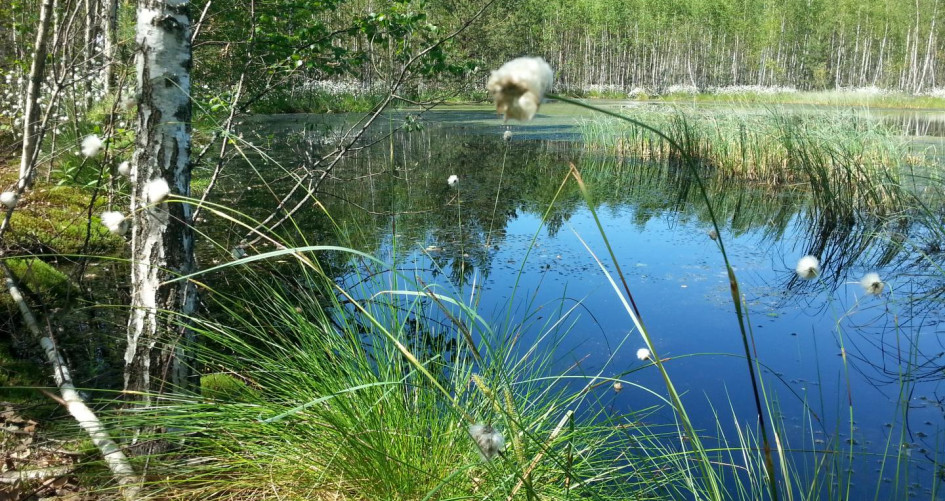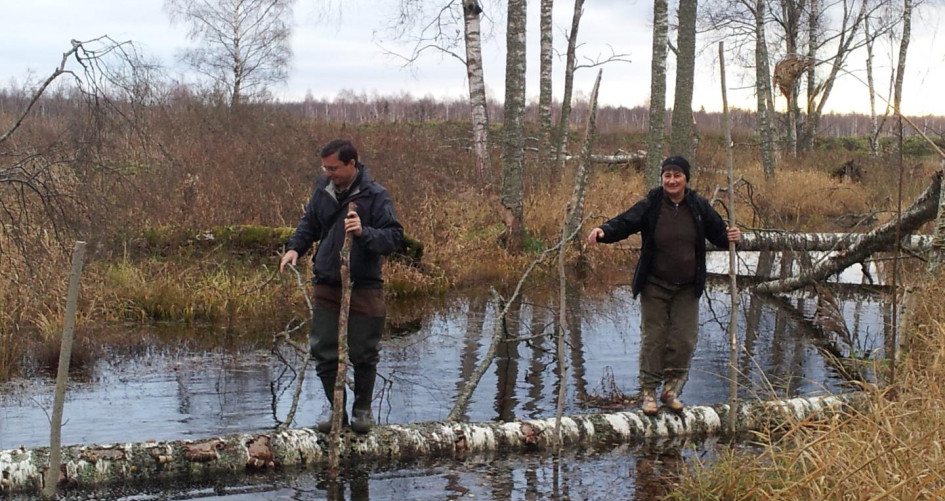Wetlands International with its partners, the Institute of Forest Science of the Russian Academy of Sciences and the Michael Succow Foundation, implemented a major peatland restoration project in Russia in response to the extensive peat fires in the summer of 2010 in the Moscow region.
The project was initiated within the framework of co-operation between the Russian Federation and the Federal Republic of Germany to spearhead the ecological rewetting of peatlands, and represents one of the largest peatland ecosystem restoration projects in the world.
Dry peatland areas are prone to fires and the inhalation of the resulting smoke and smog particles can lead to lung irritation, causing respiratory and cardiovascular problems. Effective re-wetting of the peatland ecosystems is a key greenhouse gas mitigation measure, by reducing emissions from peatland oxidation and fires. Ecologically restored peatland areas have significantly enhanced resilience against droughts, thereby lowering the risk of fires. By reducing smog occurrences, restored peatlands can reduce health and economic impacts.
Key facts
- The project represents one of the largest on-the-ground peatland restoration project in the world;
- To date, over 35,000 hectares of drained peatlands have been restored using ecological methods with another 10,000 hectares currently underway;
- The total amount of emission reductions achieved is currently estimated at 175,000 to 220,000 ton CO2 eq. per annum;
- According to an expert assessment, another total of 42,000 hectares have been optimally restored in relation to peat fire prevention in the Moscow region by using complex hydro-technical facilities;
- Paludiculture (wet agriculture on restored peatlands) and sustainable management practices have been initiated at several sites.
The problem
Peatlands cover over 8% of Russia's territory. Several million hectares of peatlands have been drained and used for agriculture, forestry and peat extraction. When peat extraction became unprofitable in the 1990s, many of those areas were subsequently abandoned. Land-use changes and drainage on peaty soils have resulted in large-scale land degradation and drained peatlands have become especially prone to major fire risk. Moreover, peat oxidation emits huge quantities of carbon dioxide (CO2), amounting to up to 100 metric tonnes per year. In the summer of 2010, peat fires and related smog around Moscow caused dramatic economic and health impacts, resulting in over 50,000 premature deaths.The problem
The solution
Wetlands International, with all their partners, developed the project as part of the International Climate Initiative led by the German Ministry of Environment, Nature Conservation, Building and Nuclear Safety and managed by the KfW bank.
In close collaboration with the Ministry of Natural Resources and Environment of the Russian Federation, the project carries out measures to return the degraded peatlands to their original water-logged state with sustainable use of these areas in a manner involving peatland cultivation (paludiculture) and biodiversity conservation.
Addressing peatland degradation is achieved in a complex and cost-effective manner, which involves peatland mapping, greenhouse gas emission monitoring, wide stakeholder consultations with social and economic appraisals before restoration, ecological design, piloting of novel restoration techniques, cost-benefit analysis of different approaches, local national and international awareness raising and knowledge sharing.
Helping the planet
Owing to the rewetting of peatland, the mitigation of greenhouse gas emissions helps to combat climate change, as well as to restore biodiversity. Recently, the project has resulted in deepened knowledge about the effects of peatlands in the global carbon cycle.
According to recent scientific estimates, peatlands store more carbon than all of the forest ecosystems combined and, despite covering only 3% of land, they play a crucial role in battling climate change, fire risk reduction and have a significant impact on the global climate. Additionally, the project fosters the establishment and protection of habitats and ecosystems, thus increasing biodiversity in these areas.
Helping people
The rewetting of drained peatlands provides benefits to a large array of beneficiaries not only for those living in close proximity to these areas, but also to all people potentially influenced by peat fire smog that can easily migrate hundreds of kilometers.
The abandoned and drained peatlands are concentrated in the central part of the most densely populated area of Russia’s European territory and their ecological restoration has significant effects on the local population who live mainly in large cities. Additionally, approximately 20 million people who live close to restored peatland are no longer exposed to the smoke and smog, with a corresponding reduction of respiratory and cardiovascular problems. Other benefits include the reduction of firefighting costs and rise in economic value of local real estate, as well as improved conditions for tourism, recreational use of the peatlands, and commercial effects of planting certain crops, such as reeds, peat mosses, alder, willow and other fast growing trees, which could replace fossil fuels, plastic-based construction, and insulation materials.
Spillover effect
Now the project is being scaled-up to reach from four to ten regions in Russia, which should ultimately cover at least 0.5 million hectares of ecologically restored peatlands. As the project results show, the costs of ecological rewetting can often be ten times cheaper than the hydro-technical approach. Due to this, the project has attracted further support from the Russian authorities, the private sector and Russian investors, who support the scaling-up of the project to other areas.
Plans to make the project more replicable include enhancement of technical capacities to implement ecological rewetting (especially through the training of new rewetting designers) and informing the Russian government to make necessary legislative changes, crucial for the success of the process. Furthermore, the potential for peatland cultivation (paludiculture) and trading in carbon credits are being assessed. The problem of fire risk and greenhouse gas emissions in peatlands is of relevance to other regions of Russia and many other countries. Therefore, the project is promoted internationally to share its unique know-how and successes.




Images owned by the activity partners, all rights reserved.





